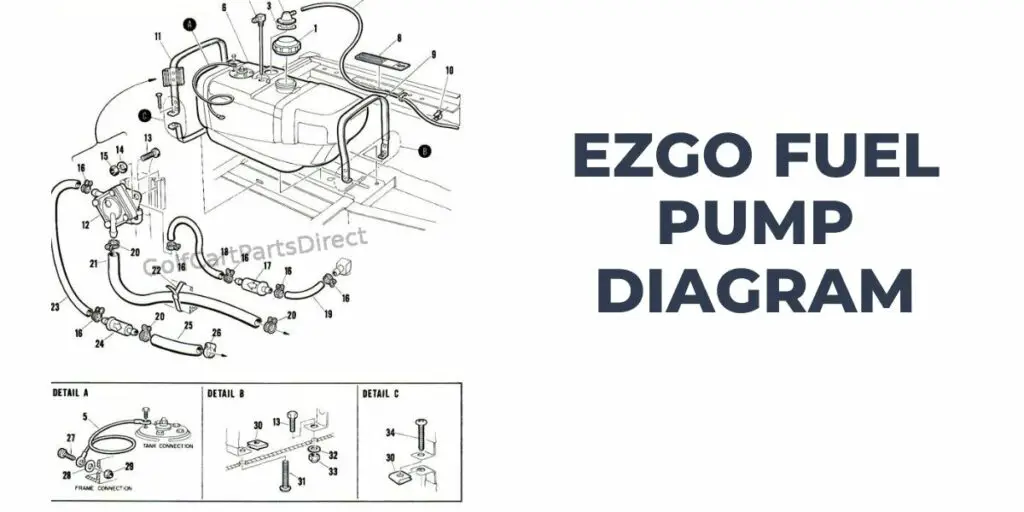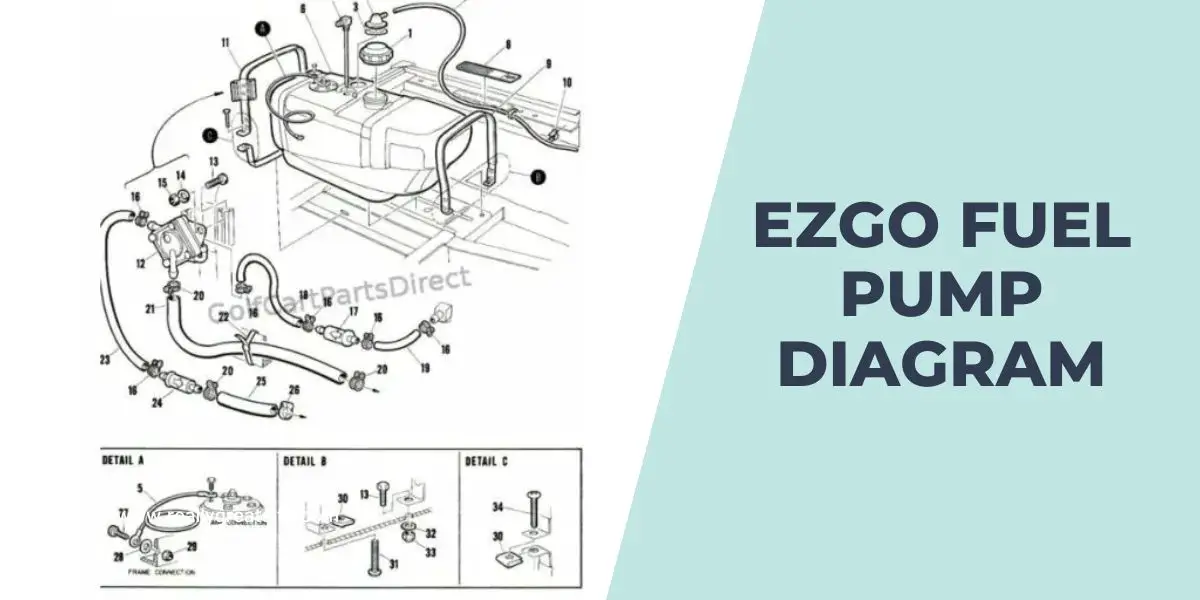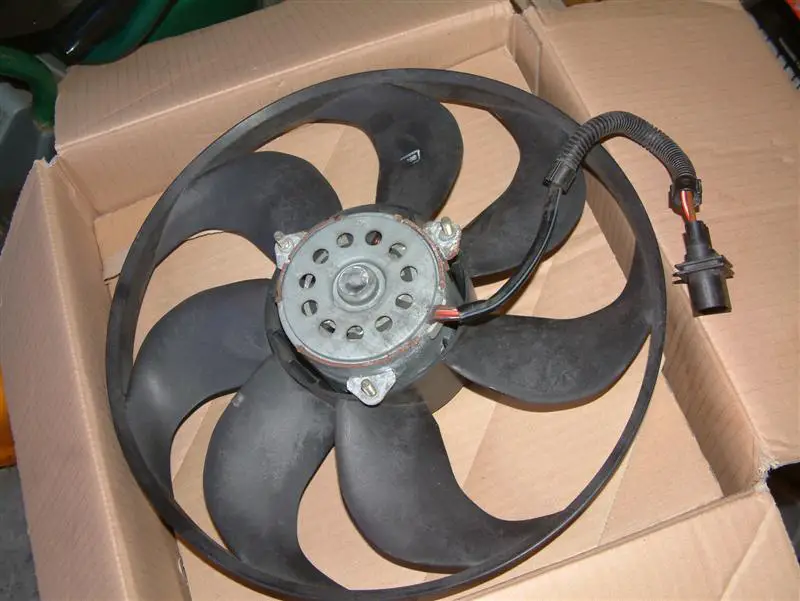I’ll never forget the weekend my old EZGO golf cart decided to quit on me right on the 7th hole. There I was, stranded, with a full round of golf ahead and a cart that wouldn’t budge.
It turned out to be a faulty fuel pump, and let me tell you, figuring out that little maze of tubes and connections without a guide was no small feat!
That’s why I’ve put together something that I wish I had on that frustrating day: a clear, easy-to-follow EZGO fuel pump diagram.
I’ll walk you through understanding and using this diagram to keep your golf cart running smoothly.
EZGO Fuel Pump Diagram: Troubleshoot & Fix Your Golf Cart
This is the EZGO fuel pump diagram:

To find what year is your golf cart is, check out my post on EZGO Models by Year.
Main Components of EZGO Fuel Pump Diagram
These are the main components of an EZGO Fuel Pump Diagram:
- Fuel Tank: The fuel tank stores the gasoline or fuel mixture in the EZGO vehicle. It is typically located at the rear of the vehicle.
- Fuel Pump: The fuel pump is an electric pump that is installed inside the fuel tank. Its primary purpose is to draw fuel from the tank and deliver it to the engine. The fuel pump generates pressure to ensure a continuous flow of fuel.
- Fuel Lines: The fuel lines are a series of tubes or hoses that carry fuel from the fuel tank to the engine. There are two primary fuel lines:
- Supply Line: This line carries fuel from the fuel pump to the engine, providing the necessary fuel for combustion.
- Return Line: The return line carries excess fuel not used by the engine back to the fuel tank.
- Fuel Filter: The fuel filter is a component placed along the fuel line, often near the engine or close to the fuel pump. Its primary function is to remove any contaminants or debris from the fuel before it reaches the engine. The fuel filter helps protect the engine from potential damage caused by impurities.
- Fuel Injectors/Carburetor: Depending on the model and age of the EZGO vehicle, it may use either fuel injectors or a carburetor.
- Fuel Injectors: In modern EZGO vehicles, fuel injectors are used. These small electronic valves spray fuel into the engine cylinders in precise amounts, mixed with air for combustion.
- Carburetor: Older EZGO models may have a carburetor. A carburetor mixes fuel with air in the correct proportions and delivers it to the engine for combustion.
For more details on how to troubleshoot your Carburetor, find my article on EZGO carburetor diagram.
How to Troubleshoot Common Issues Using the EZGO Fuel Pump Diagram
Here is how to Troubleshoot Common Issues Using the EZGO Fuel Pump Diagram:
1 No Fuel Delivery
To troubleshoot this issue, take the following steps:
- Check the fuel tank: Ensure enough fuel is in the tank.
- Look for any kinks, blockages, or leaks in the fuel lines. Clear any obstructions and repair any leaks.
- Use a multimeter to check if the fuel pump is receiving power. If not, inspect the wiring and connections for any faults or loose connections.
- If power is reaching the fuel pump but not functioning, the pump may be faulty and need replacement.
2. Weak Fuel Pressure
Do the following to troubleshoot a weak fuel pressure:
- Check the fuel filter: A clogged fuel filter can restrict fuel flow and cause low pressure. Replace the fuel filter if it is dirty or clogged.
- Inspect the fuel pump: If the fuel pump is not generating sufficient pressure, it may need to be replaced.
3. Excessive Noise
Take these steps if you notice an excessive noise:
- Check for air bubbles: Air bubbles in the fuel line can cause noise. Inspect the fuel lines for any loose connections or leaks that could introduce air into the system. Tighten connections or repair any leaks found.
- Inspect the fuel pump: A noisy fuel pump may indicate a problem with its internal components. Consider replacing the fuel pump if the noise persists.
4. Fuel Odor
Do the following to troubleshoot Fuel Odor:
- Inspect the fuel lines: Look for any signs of fuel leaks along the fuel lines. Replace any damaged or deteriorated fuel lines.
- Check the fuel tank: Ensure that the fuel tank is properly sealed. If there are cracks or leaks, replace the tank.
5. Engine Stalling or Misfiring
To troubleshoot issues with Engine Stalling or Misfiring, take the following steps:
- Inspect the fuel injectors or carburetor: Clean or replace clogged fuel injectors or carburetor jets that may be causing insufficient fuel delivery to the engine.
- Check the fuel pressure: Low fuel pressure can cause engine performance issues. Verify that the fuel pump is generating adequate pressure.
To learn more about the EZGO carburetor diagram, you can refer to the detailed schematic and components by clicking here: EZ GO Golf Cart Carburetor Diagram.
Frequently Asked Questions
Here are some Frequently Asked Questions about the EZGO Fuel Pump:
How often should I replace my EZGO fuel pump?
The lifespan of a fuel pump can vary depending on various factors, such as usage, maintenance, and driving conditions. In general, fuel pumps can last several years or more. However, if you experience symptoms of a failing fuel pump, it’s best to have it replaced as soon as possible.
Can I replace the fuel pump myself?
The replacement of a fuel pump can be a complex task and requires a certain level of mechanical expertise. It often involves accessing the fuel tank and dealing with flammable substances. It’s recommended to have a professional mechanic perform the replacement to ensure proper installation and safety.
How can I prevent fuel pump issues in my EZGO vehicle?
Regular maintenance is key to preventing fuel pump issues. It’s important to keep the fuel tank clean, change the fuel filter as recommended by the manufacturer, and use high-quality fuel to minimize the risk of contaminants damaging the pump. Additionally, avoid running the vehicle on a near-empty tank, as this can lead to fuel pump overheating.
Conclusion
Understanding the EZGO fuel pump diagram is crucial for ensuring the optimal performance of your vehicle. We’ve explored the different components and their functions, providing you with a clear picture of how fuel flows from the tank to the engine.
By referring to the diagram, you can easily troubleshoot any issues that may arise and make informed decisions about maintenance and repairs. Remember, a well-maintained fuel system leads to a smoother ride and improved fuel efficiency. So, keep this handy guide in mind and confidently hit the road!


